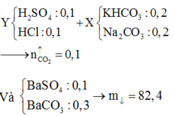Các câu hỏi tương tự
Cho các polime: poli(vinyl clorua), xenlulozơ, policaproamit, polistiren, xenlulozơ triaxetat, nilon-6,6. Số polime tổng hợp là
A. 5.
B. 2.
C. 3.
D. 4.
Cho các polime: poli(vinyl clorua), xenlulozơ, policaproamit, polistiren, xenlulozơ triaxetat, nilon-6,6. Số polime tổng hợp là
A. 5.
B. 2.
C. 3.
D. 4.
Cho các polime: poli(vinyl clorua), xenlulozơ, policaproamit, polistiren, xenlulozơ triaxetat, nilon-6,6. Số polime tổng hợp là A. 5. B. 2. C. 3. D. 4.
Đọc tiếp
Cho các polime: poli(vinyl clorua), xenlulozơ, policaproamit, polistiren, xenlulozơ triaxetat, nilon-6,6. Số polime tổng hợp là
A. 5.
B. 2.
C. 3.
D. 4.
Cho các polime sau: poli(vinyl clorua), tơ nilon–6,6, tơ visco, xenlulozo, tơ axetat, cao su buna, poli(metyl metacrylat). Số polime thuộc loại polime tổng hợp là
A. 3.
B. 4.
C. 5.
D. 2.
Cho các polime: poli(vinyl clorua), xenlulozơ, policaproamit, polistiren, xenlulozơ triaxetat, cao su buna. Số polime được điều chế từ phản ứng trùng hợp là
A. 5
B. 4
C. 3
D. 2.
Cho các polime: poli(vinyl clorua), polietilen, policaproamit, tơ nilon-7, xenlulozơ triaxetat và cao su buna-N. Số polime thuộc loại chất dẻo là
A. 5
B. 2
C. 3
D. 1
Cho dãy các polime sau: polietilen, xenlulozơ triaxetat, policaproamit, poli(vinyl clorua) và poli(etylen terephtalat). Số polime trong dãy thuộc loại tơ tổng hợp là
A. 2
B. 3
C. 4
D. 5
Trong các polime sau: poli(metyl metacrylat); polistiren; nilon-6; poli(etylen terephtalat); nilon-6,6; poli(vinyl axetat). Số polime được tổng hợp bằng phản ứng trùng ngưng là A. 2. B. 4. C. 5. D. 3.
Đọc tiếp
Trong các polime sau: poli(metyl metacrylat); polistiren; nilon-6; poli(etylen terephtalat); nilon-6,6; poli(vinyl axetat). Số polime được tổng hợp bằng phản ứng trùng ngưng là
A. 2.
B. 4.
C. 5.
D. 3.
Cho các polime: policaproamit, poli(vinyl clorua), polistiren, poli(phenol-fomanđehit), polietilen, poliisopren. Số polime được điều chế bằng phản ứng trùng hợp là
A. 5.
B. 2.
C. 3.
D. 4.




